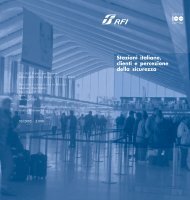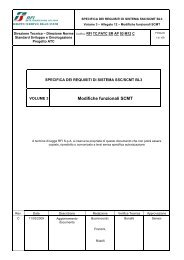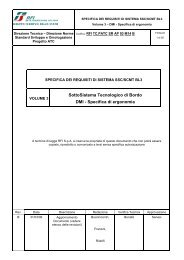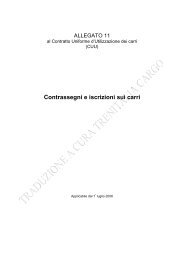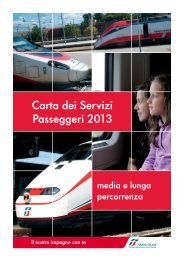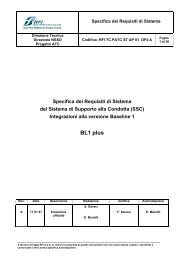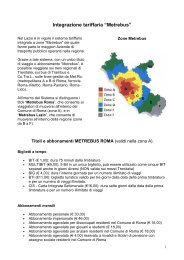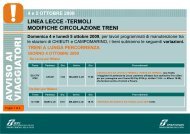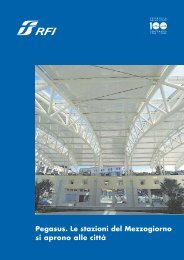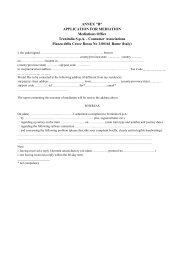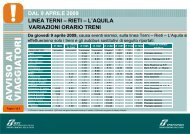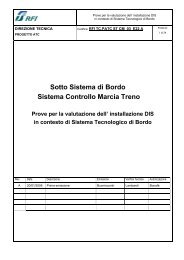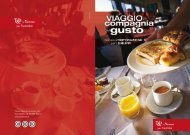Alta Velocità High Speed - Trenitalia
Alta Velocità High Speed - Trenitalia
Alta Velocità High Speed - Trenitalia
You also want an ePaper? Increase the reach of your titles
YUMPU automatically turns print PDFs into web optimized ePapers that Google loves.
3.000 – Grafica Nappa<br />
<strong>Alta</strong> <strong>Velocità</strong><br />
<strong>High</strong> <strong>Speed</strong><br />
Piazza della Croce Rossa, 1<br />
00161 Roma<br />
www.ferroviedellostato.it
<strong>Alta</strong> <strong>Velocità</strong><br />
<strong>High</strong> <strong>Speed</strong>
A LTA V ELOCITA’/A LTA C APACITA’<br />
LA METROPOLITANA D’ITALIA<br />
Dal 13 dicembre 2009, fra Torino e<br />
Salerno si viaggia con il sistema <strong>Alta</strong><br />
<strong>Velocità</strong>/<strong>Alta</strong> Capacità. Un traguardo storico<br />
per la mobilità del Paese, raggiunto a<br />
conclusione di un progetto TOTALMENTE ITALIANO NEL-<br />
L’INFRASTRUTTURA, NEI TRENI E NEL KNOW HOW. Con<br />
una tecnologia di segnalamento, l’ERTMS-ETCS livello 2,<br />
che per i massimi livelli di sicurezza garantiti è stata<br />
adottata come standard ufficiale dall’Unione Europea.<br />
La nuova rete, amica del clima e dell’ambiente, riduce i<br />
tempi di viaggio fra le città collegate, rivoluzionando il<br />
modo di muoversi e di vivere degli italiani. E libera<br />
spazi sui binari storici a vantaggio del trasporto locale<br />
e di quello merci.<br />
H IGH S PEED/H IGH C APACITY<br />
ITALY’S METRO LINK<br />
From 13 December 2009, Turin and Salerno will be joined by the <strong>High</strong> <strong>Speed</strong>/<strong>High</strong> Capacity<br />
rail link. This will be a landmark moment for Italian mobility, and the culmination of a project<br />
featuring 100% ALL-ITALIAN INFRASTRUCTURE, TRAINS AND KNOW HOW. Not to mention<br />
ERTMS-ETCS level 2 signalling technology, which has been designated the official EU standard<br />
due to the maximum standard of safety guaranteed.<br />
The new, climate and environmentally friendly rail network cuts travel times between destination cities<br />
and will completely change the way Italian people travel and live. It will also free up space on legacy<br />
rail lines, with resulting benefits for local passenger and cargo transport.
UN PROGETTO RIVOLUZIONARIO<br />
La rete AV/AC è l’opera più importante ed estesa<br />
mai realizzata in ITALIA dal dopoguerra ad oggi.<br />
Le nuove linee veloci sono il risultato di sfide<br />
impegnative, soprattutto per le caratteristiche<br />
orografiche e idrogeologiche del territorio e l’alta<br />
urbanizzazione dell’area attraversata, su cui vive e<br />
Sulle nuove direttrici quadruplicate la capacità<br />
complessiva di movimento ferroviario è più che<br />
raddoppiata. Un volano per lo sviluppo economico,<br />
sociale e culturale del Paese, con benefici anche<br />
per i pendolari, che potranno disporre di servizi<br />
migliori per efficienza e regolarità.<br />
lavora oltre il 65% della popolazione.<br />
I nuovi tracciati sono tutti a basso livello di impatto<br />
ambientale. Le interconnessioni tra la rete veloce e<br />
quella storica offrono, inoltre, utili alternative per i treni<br />
passeggeri e supporto strategico nel settore cargo.<br />
SPOSTANDO VIAGGIATORI E MERCI DALLE AUTO E<br />
DAGLI AEREI AI TRENI, a tutto vantaggio della qualità<br />
del clima e della vita, la nuova rete AV italiana è un<br />
fattore determinante per il riequilibrio modale del<br />
sistema nazionale dei trasporti.<br />
4 FERROVIE DELLO STATO
A REVOLUTIONARY<br />
PROJECT<br />
The <strong>High</strong> <strong>Speed</strong>/<strong>High</strong> Capacity system is the biggest<br />
engineering work in all respects in post-war ITALY.<br />
The new high speed lines are a triumph over adversity,<br />
on account of the elevation and particular<br />
hydrogeological features of the land, and the densely<br />
populated urban areas crossed, in which more than<br />
65% of the population live and work.<br />
The new lines are also of extremely low impact on the<br />
environment. Connections between the high speed<br />
and legacy lines also represent a useful alternative for<br />
passenger trains and a strategic support for the cargo<br />
sector.<br />
Quadrupling the lines will more than double the total<br />
amount of rail traffic carriable. This will drive the<br />
economic, social and cultural growth of the country<br />
with added benefits for commuters who will have<br />
access to more efficient and more reliable services.<br />
While the climate and quality of life can only benefit<br />
from TRANSFERRING TRAVELLERS AND CARGO FROM CARS AND<br />
AEROPLANES ONTO TRAINS, Italy's new high speed<br />
network is also key to re-distributing traffic across all<br />
modes in the national transportation system.<br />
<strong>Alta</strong> <strong>Velocità</strong> > <strong>High</strong> <strong>Speed</strong><br />
5
LE GRANDI CITTA’<br />
COME QUARTIERI<br />
NELLA METROPOLI ITALIA<br />
<br />
<br />
<br />
Con il completamento della rete veloce e il lancio dell’offerta AV<br />
da Torino a Salerno, si compie l’ultimo, decisivo passo verso LA<br />
RIVOLUZIONE DELLA MOBILITÀ ITALIANA: la nascita di un sistema di<br />
trasporto che trasforma le principali città in quartieri di un’unica,<br />
grande metropoli: l’Italia.<br />
<br />
<br />
<br />
<br />
<br />
<br />
<br />
<br />
<br />
<br />
<br />
<br />
<br />
<br />
<br />
<br />
<br />
La metropolitana veloce d’Italia, circa 1.000 km sull’asse<br />
ferroviario nazionale a maggior traffico, collega Milano a Roma<br />
in 2 ore e 59 minuti, a Napoli in 4 ore e 10 e a Firenze appena<br />
in 1 ora e 45. Con maggiori frequenze e treni che viaggiano a<br />
<br />
<br />
<br />
<br />
<br />
300 chilometri all’ora.<br />
Da dicembre 2009 anche il Sud – Est e il Nord – Est del Paese<br />
entrano nel sistema <strong>Alta</strong> <strong>Velocità</strong>, grazie alla forte crescita del<br />
ruolo dell’ETR 600 Frecciargento, ultimo nato della flotta, che<br />
viaggiando a 280 km all’ora assicura il collegamento tra Bari e<br />
<br />
<br />
<br />
<br />
<br />
<br />
la Capitale in 3 ore e 59’, tra Roma e Venezia in 3 ore e 30’ e<br />
<br />
tra Roma e Verona in solo 3 ore. Inoltre, dal giugno 2010, la<br />
metropolitana d’Italia è arrivata anche a Bolzano. Due nuove<br />
corse collegano ora le Dolomiti alla Capitale, in solo 4 ore e<br />
47’, fermando anche a Rovereto, Verona Porta Nuova, Bologna<br />
Centrale e Firenze Campo Marte.<br />
In progettazione > Planning stage<br />
In costruzione > Construction stage<br />
In esercizio > Operational<br />
In esercizio > Operational<br />
(linee veloci fino a 250 Km/h) > (fast lines at 250 Km/h)<br />
6 FERROVIE DELLO STATO
LARGE CITIES AS DISTRICTS<br />
OF THE ITALIAN METROPOLIS<br />
hour 45 minutes, with more frequent services and<br />
trains travelling at 300km/h.<br />
From December 2009 the Southeast and Northeast of<br />
The completion of the high speed rail network and<br />
opening of the Turin to Salerno corridor are the final<br />
step towards radically RESHAPING TRAVEL IN ITALY, with<br />
the inauguration of a transportation system that will<br />
make big cities feel like they are just corners of one<br />
big metropolis.<br />
Italy’s high-speed metro, more than 1,000 km of track<br />
along the most saturated national rail route, connects<br />
Milan to Rome in 2 hours and 59 minutes, to Naples<br />
in 4 hours and 10 minutes, and to Florence in just 1<br />
the country will also become part of the <strong>High</strong> <strong>Speed</strong><br />
system, thanks to the increasing role played by the ETR<br />
600 Frecciargento, the latest edition to the fleet which<br />
connects Bari and the capital in 3 hours 59 minutes,<br />
Rome and Venice in 3 hours 30 minutes and Rome<br />
and Verona in just 3 hours. Italy’s metro also extends<br />
to Bolzano from June 2010. Two new lines now<br />
connect the Dolomites to the capital in just 4 hours 47<br />
minutes, stopping at Rovereto, Verona Porta Nuova,<br />
Bologna Central and Florence Campo Marte.<br />
<strong>Alta</strong> <strong>Velocità</strong> > <strong>High</strong> <strong>Speed</strong><br />
7
LO SVILUPPO DELLA RETE<br />
Nei prossimi anni è previsto anche il<br />
completamento della trasversale Milano-Trieste,<br />
sulla quale, già oggi, si innesta il quadruplicamento<br />
della Bologna-Verona, crocevia fondamentale per i<br />
collegamenti con il Centro Europa.<br />
Gli interventi SULLA RETE A SUD DI NAPOLI e Salerno<br />
prevedono il POTENZIAMENTO INFRASTRUTTURALE E<br />
TECNOLOGICO DELLE LINEE ESISTENTI E LA<br />
COSTRUZIONE DI NUOVI TRATTI PER I COLLEGAMENTI<br />
VELOCI CON LA SICILIA.<br />
Nel 2008 è stato attivato il nuovo collegamento<br />
AV/AC Napoli-Salerno (linea a Monte del Vesuvio)<br />
che, con il tratto AV/AC Roma-Napoli, permette il<br />
collegamento veloce Nord-Sud.<br />
Tra i progetti in via di sviluppo, il quadruplicamento<br />
della Salerno-Battipaglia, il completamento del<br />
raddoppio della Messina-Palermo e della Messina-<br />
Catania.<br />
8 FERROVIE DELLO STATO
THE NETWORK DEVELOPMENT<br />
Over the next few years, we will also see completion<br />
of the Milan-Trieste segment which already connects to<br />
the quadrupled Bologna-Verona lines, i.e. an essential<br />
crossroads for connections to Central Europe.<br />
Work on LINES RUNNING SOUTH OF NAPLES and Salerno<br />
will also aim to UPDGRADE THE INFRASTRUCTURE AND<br />
TECHNOLOGY DEPLOYED ON EXISTING LINES AS WELL AS<br />
ADDING NEW SEGMENTS TO PROVIDE FAST LINKS WITH SICILY.<br />
The new <strong>High</strong> <strong>Speed</strong>/<strong>High</strong> Capacity Naples-Salerno<br />
link (also known as the Monte del Vesuvio line in<br />
Italian) was opened in 2008 and, together with the<br />
Rome-Naples <strong>High</strong> <strong>Speed</strong>/<strong>High</strong> Capacity segment,<br />
allows fast North-South connections. Plans exist to<br />
quadruple tracks between Salerno and Battipaglia as<br />
well as complete the Messina-Palermo dual track , and<br />
Messina-Catania routes.<br />
<strong>Alta</strong> <strong>Velocità</strong> > <strong>High</strong> <strong>Speed</strong><br />
9
PAESE EUROPA<br />
Nella nuova Europa allargata, le linee AV/AC<br />
italiane, inserite nei principali corridoi europei<br />
della rete TEN (Trans European Network), giocano<br />
un ruolo fondamentale per valorizzare la centralità,<br />
l’accessibilità e l’integrazione del territorio italiano<br />
e del suo sistema produttivo e logistico.<br />
Le FS sono ora pronte ad affrontare anche la<br />
competizione internazionale.<br />
Abitanti per km²<br />
da 1 a 10<br />
da 10 a 25<br />
da 25 a 50<br />
da 50 a 100<br />
da 100 a 200<br />
più di 200<br />
Città con più di 1 000 000 di abitanti<br />
Città con più di 3 000 000 di abitanti<br />
Città principali interessate dalla Rete TEN<br />
con meno di 1 000 000 di abitanti<br />
Progetti Prioritari della Rete TEN<br />
Progetto Prioritario n. 1<br />
Progetti Prioritari nn. 3 e 6<br />
Progetto Prioritario n. 24<br />
Corridoio VIII<br />
EUROPE AS A COUNTRY<br />
Autostrade del mare<br />
Sud Europa<br />
In the new enlarged Europe, Italy’s HS/HC lines,<br />
included in the main European corridors of the TEN<br />
(Trans European Network), play a fundamental role in<br />
highlighting the centrality, accessibility and integration<br />
of Italy and of its productive and logistical systems.<br />
FS is now even ready to meet international<br />
competition.<br />
12 FERROVIE DELLO STATO
13<br />
<strong>Alta</strong> <strong>Velocità</strong> > <strong>High</strong> <strong>Speed</strong><br />
24<br />
1<br />
VIII<br />
3<br />
6<br />
V<br />
ALGERI<br />
BELGRADO<br />
BUCAREST<br />
ODESSA<br />
SMIRNE<br />
ISTANBUL<br />
KIJEV<br />
MINSK<br />
PALERMO<br />
SAN PIETROBURGO<br />
MARSEILLE<br />
BIRMINGHAM<br />
LISBOA<br />
MADRID<br />
ROMA<br />
LONDON<br />
PARIS<br />
BRUXELLES<br />
LUXEMBOURG<br />
BERLIN<br />
KØBENHAVN<br />
STOCKHOLM<br />
TALLINN<br />
HELSINKI<br />
RIGA<br />
WARSZAWA<br />
WIEN<br />
BUDAPEST<br />
TIRANA<br />
SKOPIE<br />
SOFIJA<br />
PRAHA<br />
PORTO<br />
SINES<br />
FARO<br />
ALGECIRAS<br />
BARCELONA<br />
BORDEAUX<br />
TOURS<br />
LION<br />
NIMES<br />
TORINO<br />
GENOVA<br />
BOLOGNA<br />
VENEZIA TRIESTE<br />
LJUBLJANA<br />
BRINDISI<br />
BARI<br />
IGOUMENITSA<br />
KALAMATA<br />
ATHINA<br />
BURGAS<br />
VARNA<br />
MILANO<br />
BASEL<br />
ANTWERPEN<br />
ROTTERDAM<br />
AMSTERDAM<br />
BREMEN HAMBURG<br />
GDANSK<br />
LVOV<br />
HANNOVER<br />
ERFURT<br />
FRANKFURT<br />
KÖLN<br />
MUENCHEN<br />
NURNBERG<br />
BRNO<br />
LIVERPOOL<br />
FELIXSTOWE<br />
DUBLIN<br />
HULL<br />
BELFAST<br />
CORK<br />
VERONA<br />
NAPOLI<br />
LA CORUÑA<br />
CASABLANCA
L’AV/AC TORINO-<br />
MILANO-NAPOLI<br />
SALERNO IN CIFRE<br />
L’OPERA<br />
> 254 km della “Direttissima” Firenze-Roma<br />
già in esercizio dal 1978<br />
> 661 km di nuove linee veloci: 494 km<br />
attivate a dicembre 2005 e dicembre 2008<br />
(Roma-Napoli, Torino-Novara, Milano-<br />
Bologna, Napoli-Salerno) e 147 km a<br />
dicembre 2009 (Novara-Milano e Bologna-<br />
Firenze e Napoli). Restano da completare i<br />
soli sottoattraversamenti di Bologna e<br />
Firenze per circa 20 km<br />
L E NUOVE LINEE<br />
> 145 km di nuove gallerie<br />
> 516 km di nuovi viadotti, ponti,<br />
trincee e rilevati<br />
> 77 km di nuove interconnessioni<br />
tra le linee AV e la rete storica<br />
> 7 nuove stazioni<br />
T ERRITORIO E AMBIENTE<br />
> 6 regioni, 17 province e 161 comuni<br />
attraversati dalle nuove linee<br />
La linea Torino-Milano-Bologna-Firenze-Roma-<br />
Salerno è parte del Progetto Prioritario<br />
n.1/Corridoio I Berlino-Palermo.<br />
La Milano-Verona-Venezia è inserita nel Progetto<br />
Prioritario n. 6/Corridoio V Lisbona-Kiev<br />
e la Milano-Genova (Terzo Valico dei Giovi)<br />
nel Progetto Prioritario n. 24/Corridoio<br />
dei Due Mari Rotterdam-Genova.<br />
> 230 km di barriere antirumore<br />
> 780 km di nuova viabilità<br />
e varianti stradali<br />
> 1.670 ettari di interventi a verde<br />
> 300 accordi volontari per l’inserimento<br />
socio-ambientale dell’opera<br />
> Circa il 25% dell’investimento<br />
per le spese socio-ambientali<br />
14 FERROVIE DELLO STATO
The Turin-Milan-Bologna-Florence-Rome-Salerno line is<br />
part of the Priority Project no. 1/ Berlin-Palermo<br />
Corridor I. The Milan-Verona-Venice line is part of the<br />
Priority Project no. 6/ Lisbon-Kiev Corridor V and the<br />
Milan-Genoa line (Third Giovi Pass) is part of the<br />
Priority Project no. 24/ Rotterdam-Genoa Two Seas<br />
Corridor.<br />
THE TURIN-MILAN-NAPLES-SALERNO HS/HC NETWORK IN NUMBERS<br />
THE NETWORK<br />
> 254 km of the “Direttissima” Florence-<br />
Rome line operational since 1978<br />
> 661 km of new high speed lines:<br />
494km opened in December 2005<br />
and December 2008 (Rome-Naples,<br />
Turin-Novara, Milan-Bologna,<br />
Naples-Salerno) and 147 km in<br />
December 2009 (Novara-Milan and<br />
Bologna-Florence and Naples).<br />
THE NEW LINES<br />
> 145 km of new tunnels<br />
> 516 km of new overpasses, bridges,<br />
trenches and embankments<br />
> 77 km of new interconnections<br />
between the new lines<br />
and the existing railway network<br />
> 7 new stations<br />
TERRITORY AND ENVIRONMENT<br />
> 6 regions, 17 provinces<br />
and 161 municipalities<br />
traversed by the new lines<br />
> 230 km of noise barriers<br />
> 780 km of new roads<br />
and alternative routes<br />
> 1,670 hectares of landscaped<br />
greenery<br />
> 300 voluntary agreements for the<br />
line’s socio-environmental inclusion<br />
> approximately 25% of the investment<br />
covers socio-environmental costs<br />
<strong>Alta</strong> <strong>Velocità</strong> > <strong>High</strong> <strong>Speed</strong><br />
15
IL PRIMATO DELLA TECNOLOGIA ITALIANA<br />
MASSIMA SICUREZZA, MASSIMA VELOCITA’<br />
L<br />
e Ferrovie italiane, prime in Europa, hanno adottato sulle nuove linee<br />
AV/AC l’European Railway Traffic Management System/European Train<br />
Control System (ERTMS/ETCS) di livello 2, un sistema esclusivo per il controllo<br />
della circolazione PROGETTATO E SVILUPPATO INTERAMENTE IN<br />
I TALIA, che garantisce il più elevato livello di tecnologia e di sicurezza.<br />
L E FS SONO STATE LE PRIME AL MONDO A UTILIZZARLO ottenendo nel 2006, a<br />
Montreal, il Best Paper Award, un importante riconoscimento da parte della comunità<br />
ferroviaria internazionale. Adottato dall’UE come standard di riferimento per le nuove<br />
reti transnazionali ad <strong>Alta</strong> <strong>Velocità</strong>, l’ERTMS-ETCS di livello 2 elimina la possibilità<br />
dell’errore umano, assicurando il controllo della marcia del treno istante per istante.<br />
Massima sicurezza alle massime velocità, quindi, e maggior frequenza dei convogli,<br />
che possono circolare anche a pochi minuti di distanza l’uno dall’altro.<br />
THE LEADERSHIP<br />
OF ITALIAN TECHNOLOGY<br />
MAXIMUM SECURITY, MAXIMUM SPEED<br />
On the new HS/HC lines, Italy’s railways, the first in Europe, adopted the level 2 European<br />
Railway Traffic Management System/European Train Control System (ERTMS/ETCS), an<br />
exclusive system for controlling railway traffic DESIGNED AND DEVELOPED ENTIRELY IN<br />
I TALY, that ensures the highest levels of technological innovation and safety. FS WAS THE<br />
FIRST IN THE WORLD TO ADOPT IT, and in 2006 received an important acknowledgement, in Montreal, the<br />
Best Paper Award from the international railway community. Adopted by the EU as the reference standard for<br />
new transnational <strong>High</strong>-<strong>Speed</strong> networks, level 2 ERTMS-ETCS eliminates the possibility of human error, ensuring<br />
continuous control over the train’s movement. This results in the highest degree of safety at the highest speeds,<br />
enabling a greater frequency of trains, which may run even only a few minutes apart from one another.
M ILANO-ROMA, IL TRENO<br />
TORNA PROTAGONISTA<br />
S ERVIZI PIÚ VELOCI, PIÚ FREQUENTI<br />
E PIÚ CONVENIENTI<br />
RISPETTO ALL’ OFFERTA AEREA.<br />
Già nel novembre 2009 <strong>Trenitalia</strong> è stata premiata<br />
a Londra con il GLOBAL AWARD del WORLD TRAVEL<br />
MARKET per il record di passeggeri trasportati sul<br />
nuovo network AV: oltre 10 milioni in 10 mesi.<br />
Dal 13 dicembre 2009 Milano e Roma sono ancora<br />
più vicine: TRA MILANO CENTRALE E ROMA TERMINI<br />
IL VIAGGIO DURA 2 ORE E 59 MINUTI SENZA FERMATE<br />
INTERMEDIE. E TRA MILANO ROGOREDO E ROMA<br />
TIBURTINA SOLO 2 ORE E 45 MINUTI. Altri<br />
collegamenti prevedono fermate a Firenze Santa<br />
Maria Novella e a Bologna Centrale, e assicurano<br />
il viaggio in 3 ORE E 30 MINUTI.<br />
ridotti anche i tempi di viaggio per le altre<br />
destinazioni: solo 37 MINUTI DA FIRENZE A<br />
BOLOGNA; UN’ORA E 45 DA FIRENZE A MILANO<br />
E 4 ORE E 10 da Milano a Napoli e da Roma a<br />
Torino. Tra ROMA E VERONA si impiegano solo 3<br />
ORE, tra la capitale e Venezia 3 ORE E 30 MINUTI<br />
e tra Roma e Bolzano 4 ORE E 47 MINUTI.<br />
Migliorano anche i tempi tra Roma e Napoli, che<br />
Sulla rotta Milano-Roma, circa il 50% dei<br />
viaggiatori preferisce IL TRENO ALL’AEREO, PERCHÉ<br />
PIÙ COMODO, PIÙ ACCESSIBILE E PIÙ VELOCE.<br />
scendono a UN’ORA E 10 MINUTI e quelli tra la<br />
Capitale e Bari, ora raggiungibile in 3 ORE E 59<br />
MINUTI.<br />
Con l’inaugurazione delle nuove linee sono stati<br />
18 FERROVIE DELLO STATO
MILAN – ROME,<br />
TRAINS BACK IN THE LIMELIGHT<br />
On the Milan-Rome line, about 50% of<br />
FASTER, MORE FREQUENT<br />
AND CHEAPER THAN AIR TRAVEL.<br />
Such is the success of the Italian HS services<br />
passengers stated they prefer TRAVELLING BY RAIL<br />
AND NOT PLANE, AS IT IS EASIER, FASTER AND MORE<br />
ACCESSIBLE.<br />
that, in November 2009 in London, <strong>Trenitalia</strong><br />
was presented with the WORLD TRAVEL MARKET<br />
GLOBAL AWARD in recognition of the record<br />
number of passengers transported on the new<br />
HS network: over 10 million people in 10<br />
months.<br />
From 13 December 2009, Milan and Rome are<br />
going to be even closer: TRAVELLING FROM MILAN<br />
CENTRAL TO ROMA TERMINI WILL TAKE ONLY 2 HOURS 59<br />
MINUTES ON A DIRECT SERVICE. OR JUST2 HOURS 45<br />
MINUTES FROM ROGOREDO TO TIBURTINA. Other services<br />
will stop at Florence Santa Maria Novella and<br />
Bologna Central, with a total travel time of 3<br />
HOURS 30 MINUTES.<br />
Opening of the new lines cuts travel times to<br />
other destinations as well: JUST 37 MINUTES FROM<br />
FLORENCE TO BOLOGNA; 1 HOUR 45 MINUTES FROM<br />
FLORENCE TO MILAN AND 4 HOURS 10 MINUTES FROM<br />
MILAN TO NAPLES, and from Rome to Turin. To get<br />
from ROME TO VERONA takes just 3 HOURS, while<br />
travel between the CAPITAL AND VENEZIA takes 3<br />
HOURS 30 MINUTES and between ROME AND<br />
BOLZANO 4 HOURS 47 MINUTES. Journeys<br />
between ROME AND NAPLES now take just 1 HOUR<br />
10 MINUTES, while transit times between the<br />
CAPITAL AND BARI have also been reduced to 3<br />
HOURS 59 MINUTES.<br />
<strong>Alta</strong> <strong>Velocità</strong> > <strong>High</strong> <strong>Speed</strong><br />
19
COLLEGAMENTI DA DICEMBRE 2007 DA DICEMBRE 2008 DA DICEMBRE 2009<br />
M ILANO-FIRENZE 2 H 44’ 2H 10’ 1H 45’<br />
R OMA-MILANO NO STOP 4 H 05’ 3H 30’ 2H 59’<br />
R OMA-MILANO 4 H 30’ 3H 59’ 3H 30’<br />
R OMA-NAPOLI 1 H 27’ 1H 21’ 1H 10’<br />
L’offerta si arricchisce di nuovi treni, con<br />
destinazione o provenienza Napoli e Torino, che<br />
fermano a Roma Tiburtina, Firenze Campo di<br />
Marte, Milano Rogoredo e Milano Porta Garibaldi.<br />
Nelle fasce di punta sono previsti 4 collegamenti<br />
OGNI ORA: in questo modo aumentano i posti e<br />
Migliora anche la frequenza, in particolare nelle<br />
fasce orarie con maggiore domanda.<br />
diventa più ampia la scelta per spostarsi<br />
comodamente dal centro città.<br />
20 FERROVIE DELLO STATO
The service boasts new trains travelling to and from<br />
Naples and Turin, stopping at Roma Tiburtina, Firenze<br />
Campo di Marte, Milano Rogoredo and Milano Porta<br />
At peak times there will be 4 TRAINS EVERY HOUR: this<br />
will increase the number of seats available and make<br />
it easier to get out of the city centre.<br />
Garibaldi.<br />
More frequent services are also guaranteed,<br />
especially at peak times.<br />
CONNECTIONS FROM DECEMBER 2007 FROM DECEMBER 2008 FROM DECEMBER 2009<br />
MILAN-FLORENCE 2H 44’ 2H 10’ 1H 45’<br />
ROME-MILAN NO STOP 4H 05’ 3H 30’ 2H 59’<br />
ROME-MILAN 4H 30’ 3H 59’ 3H 30’<br />
ROME-NAPLES 1H 27’ 1H 21’ 1H 10’<br />
<strong>Alta</strong> <strong>Velocità</strong> > <strong>High</strong> <strong>Speed</strong><br />
21
SERVIZI PER IL CLIENTE IN OGNI MOMENTO DEL VIAGGIO<br />
PRIMA DI PARTIRE<br />
Servizi di informazione e vendita on line<br />
e di telefonia mobile, call center dedicati,<br />
programma di fidelizzazione con la<br />
nuova CARTAFRECCIA<br />
IN STAZIONE<br />
Biglietterie, self-service, Club, desk al<br />
binario e percorsi segnalati.<br />
Nuovi servizi “DOOR TO DOOR<br />
per i bagagli<br />
A BORDO<br />
Ristorazione di qualità, welcome drink,<br />
giornali, nuove sellerie e poggiatesta in<br />
prima classe, rivista di bordo, prese di<br />
corrente per pc e cellulare.<br />
I clienti che viaggiano con l’<strong>Alta</strong> <strong>Velocità</strong> FS<br />
LA RISTORAZIONE DI QUALITÀ’<br />
possono prenotare al Call Center 892021<br />
attraverso un’opzione dedicata o collegandosi al<br />
sito www.ferroviedellostato.it. I servizi <strong>Alta</strong> <strong>Velocità</strong><br />
sono facilmente riconoscibili e i viaggiatori possono<br />
richiedere assistenza anche al binario di partenza<br />
grazie ai desk dedicati che permettono cambi<br />
prenotazione fino all’ultimo minuto.<br />
Tecniche nuove e sapori antichi, a bordo delle Frecce FS.<br />
Italianità, familiarità e freschezza sono le parole d’ordine sul<br />
Frecciarossa e sul Frecciargento, dove il mangiar bene è<br />
parte integrante dell’esperienza di viaggio e alla portata di<br />
tutti. Si va dalle ricette tradizionali e gourmet, realizzate in<br />
collaborazione con nutrizionisti e tecnologi alimentari, ai<br />
sandwich di qualità e ai prodotti del territorio.<br />
Dal 13 dicembre 2009 Roma è più vicina anche ad<br />
altre città non comprese nella rete <strong>Alta</strong> <strong>Velocità</strong>.<br />
Grazie all’ottimizzazione del sistema delle fermate<br />
dei treni Frecciargento e Frecciabianca, Bari,<br />
Lamezia Terme, Venezia e Verona si raggiungono<br />
Il tutto accompagnato da una<br />
selezione di vini italiani, dalle<br />
proprietà organolettiche<br />
decisamente superiori anche<br />
alle grandi etichette d’Oltralpe.<br />
dalla Capitale con tempi ridotti.<br />
22 FERROVIE DELLO STATO
NEW CUSTOMER SERVICES AT EVERY PART OF THE ROUTE<br />
BEFORE SETTING OFF<br />
Online and mobile info and selling services,<br />
dedicated call centres, loyalty schemes<br />
(new CARTAFRECCIA card)<br />
STATION<br />
Ticket offices, self-service machines,<br />
club, platform desk and indicated route<br />
New “DOOR TO DOOR” bagagge<br />
service<br />
ON BOARD<br />
<strong>High</strong> quality catering, welcome drink,<br />
newspapers, new seats and head rests<br />
in first class, onboard magazine, PC<br />
and mobile phone sockets.<br />
Passengers travelling on FS <strong>High</strong> <strong>Speed</strong> trains can<br />
book at the 892021Call Centre on a dedicated line<br />
Terme, Venice and Verona are all within much shorter<br />
travel times of the capital.<br />
or by logging onto to www.ferroviedellostato.it. The<br />
<strong>High</strong> <strong>Speed</strong> services are easy to recognize and<br />
HIGH-QUALITY CATERING<br />
passenger assistance is available right on the platform<br />
at dedicated desks where passengers can make lastminute<br />
booking changes.<br />
From 13 December 2009, Rome will be a lot closer to<br />
a lot of other cities too, even those that are not part of<br />
the <strong>High</strong> <strong>Speed</strong> network. By reorganising stops on<br />
Frecciargento and Frecciabianca routes, Bari, Lamezia<br />
New technology is combined with traditional flavours<br />
on board the FS <strong>High</strong> <strong>Speed</strong> trains. Italian style,<br />
friendly service and fresh food are assured on<br />
Frecciarossa and Frecciargento trains, where eating<br />
well is an integral part of the travel experience and<br />
well within everyone’s budget. From authentic recipes<br />
and gourmet dishes, created with the help of<br />
nutritionists and the latest food technology, to quality<br />
sandwiches and local produce. All accompanied by a<br />
selection of wines from distinguished Italian and<br />
French labels.<br />
<strong>Alta</strong> <strong>Velocità</strong> > <strong>High</strong> <strong>Speed</strong><br />
23
IN ARRIVO IL TRENO DEL FUTURO<br />
COME FRECCE<br />
Il treno delle FS potrà superare i 400 chilometri orari e sulla<br />
nostra rete viaggerà a 360 km/h. A crearlo sarà la società<br />
vincitrice della gara internazionale lanciata dalle Ferrovie<br />
dello Stato per una commessa di 50 treni ad “altissima velocità”<br />
del valore di oltre 1,2 miliardi di euro. La gara ha<br />
suscitato l’interesse delle imprese costruttrici più importanti<br />
del mondo e ai concorrenti è stato chiesto di far viaggiare il<br />
treno alla velocità di 360 km/h, garantendo la trasmissione<br />
degli stessi sforzi e l’accelerazione che si hanno a 300.<br />
V ELOCITÀ, INNOVAZIONE, COMFORT,<br />
SICUREZZA. E’ quanto offrono i nuovi treni<br />
Eurostar Italia <strong>Alta</strong> <strong>Velocità</strong>, la più moderna<br />
esperienza di viaggio del Paese.<br />
Oggi la flotta AV è composta dai FRECCIAROSSA<br />
– VELOCITÀ 360 KM/H FRECCIARGENTO –<br />
VELOCITÀ 280 KM/H – E FRECCIABIANCA –<br />
VELOCITÀ 200 KM/H.<br />
La flotta AV si arricchirà di 50 convogli di nuova<br />
concezione. I treni dispongono di interni pensati<br />
per offrire il MASSIMO COMFORT ai viaggiatori,<br />
attraverso la ricerca di soluzioni adatte a<br />
garantire la vivibilità degli ambienti, climatizzati<br />
e insonorizzati, oltre che dotati di luminosità e<br />
ampia visibilità verso l’esterno delle vetture.<br />
Particolare attenzione, inoltre, è rivolta agli<br />
aspetti di manutenzione, per garantire alti<br />
standard di servizio e di sicurezza attraverso<br />
impianti dedicati e con personale specializzato.<br />
26 FERROVIE DELLO STATO
FAST AS BULLET<br />
SPEED, INNOVATION, COMFORT, SAFETY. They are all<br />
offered by the new Eurostar Italy <strong>High</strong> <strong>Speed</strong> trains,<br />
the most modern way to travel. Today the HS fleet<br />
comprises the FRECCIAROSSA (RED ARROW) – TRAVELING AT<br />
360 KM/H – FRECCIARGENTO (SILVER ARROW) – TRAVELING<br />
AT 280 KM/H – AND FRECCIABIANCA (WHITE ARROW) –<br />
TRAVELING AT 200 KM/H.<br />
The HS fleet will see the addition of 50 trains of new<br />
conception whose top speed will exceed 350 km/h.<br />
The HS trains are equipped with interiors designed<br />
to provide MAXIMUM COMFORT to passengers,<br />
through the implementation of solutions that include climate<br />
control and soundproofing, as well<br />
as excellent lighting and outside visibility.<br />
Special attention has also been given to maintenance, a<br />
fundamental factor in guaranteeing high service<br />
and safety standards through dedicated systems<br />
and specialized personnel.<br />
THE TRAIN OF THE FUTURE HAS ARRIVED<br />
FS train of the future will have a top speed in excess of 400<br />
kilometres per hour and will travel at up to 360 km/h on our<br />
network. It will be designed and built by the winning bidder of<br />
an international call for tenders, issued by Ferrovie dello Stato,<br />
for an order of 50 “bullet” trains worth over 1.2 billion euros.<br />
The tender request attracted interest from some of the world’s<br />
leading rail transport manufacturers, whose task was to design<br />
a train which would travel at 360 km/h transmitting the same<br />
track force and having the same acceleration as existing trains<br />
at 300 km/h.<br />
<strong>Alta</strong> <strong>Velocità</strong> > <strong>High</strong> <strong>Speed</strong><br />
27
TRAFFICO MERCI PIU’ FLUIDO<br />
A trarne vantaggio è anche il trasporto combinato,<br />
nel quale gli operatori intermodali ricercano,<br />
Il sistema italiano AV/AC, con i nuovi collegamenti<br />
nei nodi, produce effetti positivi anche sul servizio<br />
merci che oggi grava per il 75 per cento<br />
sempre più, tempi di consegna rapidi e certi<br />
per migliorare i propri servizi e sfruttarne al meglio<br />
le potenzialità.<br />
sulle direttrici della “grande T”, Nord-Sud<br />
e Nord Ovest-Nord Est.<br />
28 FERROVIE DELLO STATO
SMOOTHER FREIGHT TRAFFIC<br />
With its new hub links, the Italian HS/HC system also<br />
produces positive effects on freight services, 75% of<br />
which presently concerns the main lines of the “big T”,<br />
extending from North to South.<br />
and from the Northwest to the Northeast.<br />
Combined transport, in which intermodal operators<br />
try to achieve faster and more predictable<br />
delivery times in order to improve their services<br />
and to best leverage their potentialities, also benefit.<br />
<strong>Alta</strong> <strong>Velocità</strong> > <strong>High</strong> <strong>Speed</strong><br />
29
ARCHITETTURA PER LE CITTA’<br />
LE STAZIONI DIVENTANO PROTAGONISTE<br />
N<br />
ei grandi NODI METROPOLITANI di Torino, Milano, Bologna, Firenze, Roma e Napoli, le stazioni<br />
destinate ad accogliere i treni AV sono state RISTRUTTURATE O SONO IN VIA DI RISTRUT-<br />
TURAZIONE O DI INTEGRAZIONE CON IMPIANTI COMPLETAMENTE NUOVI, progettati da architetti<br />
vincitori di concorsi internazionali. Stazioni, dunque, protagoniste di importanti interventi di<br />
riqualificazione urbanistica ed espressione di un nuovo linguaggio architettonico, concepite come spazi non<br />
più dedicati alle sole attività ferroviarie, ma anche luoghi di incontro e comunicazione.<br />
Progetti pilota del nuovo modo di intendere le stazioni come piazze urbane sono stati il restyling di ROMA<br />
TERMINI e quello recente di MILANO CENTRALE.<br />
GREAT ARCHITECTURE FOR OUR CITIES<br />
RAILWAY STATIONS IN THE SPOTLIGHT<br />
I<br />
n the large METROPOLITAN NODES of Turin, Milan, Bologna, Florence, Rome and Naples, the stations that<br />
will handle HS trains have been RENOVATED OR ARE IN THE PROCESS OF BEING RENOVATED OR INTEGRATED<br />
WITH NEWLY-BUILT INSTALLATIONS, designed by international award-winning architects. These stations will<br />
therefore be at the center of major urban requalification measures and will embody a new architectural language:<br />
conceived as spaces that are no longer dedicated solely to railway operations but also as meeting places.<br />
The pilot projects of this new conception of stations as new city squares were the restyling of ROME TERMINI, and,<br />
more recently, of MILAN CENTRAL STATION.
LA RIQUALIFICAZIONE DELLA STAZIONE CENTRALE,<br />
principale terminal ferroviario di MILANO,<br />
centro nevralgico della mobilità urbana<br />
e vera e propria porta d’accesso alla città<br />
anche per i futuri visitatori dell’Expo 2015, segna<br />
una tappa fondamentale per il potenziamento<br />
dei trasporti regionali e metropolitani e valorizza<br />
il ruolo della stazione come crocevia delle nuove<br />
linee <strong>Alta</strong> <strong>Velocità</strong>/<strong>Alta</strong> Capacità.<br />
La stazione, definita da Frank Lloyd Wright “la più<br />
bella del mondo”, è nata nel primo dopoguerra<br />
su progetto dell’architetto Ulisse Stacchini: un’opera<br />
fastosa e monumentale, ispirata allo stile tardo<br />
Liberty della Secessione viennese.<br />
Il progetto di riqualificazione, elaborato<br />
dall’architetto Marco Tamino e realizzato da Grandi<br />
Stazioni, società del Gruppo Ferrovie dello Stato,<br />
punta a coniugare passato e futuro, attraverso<br />
interventi di restauro conservativo delle architetture<br />
Liberty e dei preziosi elementi decorativi, con l’uso<br />
di tecniche non invasive. A ciò si affianca un piano<br />
di interventi per migliorare la qualità degli spazi, il<br />
comfort e la sicurezza, con l’uso di tecnologie<br />
avanzate ma nel pieno rispetto dell’identità<br />
storica e architettonica della stazione.<br />
32 FERROVIE DELLO STATO
THE RECLAMATION OF THE CENTRAL STATION MILAN’s main<br />
railway terminal, a crucial hub of MILAN’s mobility and a<br />
real gateway granting access to the city for the future<br />
visitors of the Expo 2015 – is a key step in the<br />
improvement of regional and metropolitan transport, and<br />
enhances the station’s role as a hub for the new <strong>High</strong><br />
<strong>Speed</strong>-<strong>High</strong> Capacity railway lines. The station, which<br />
Frank Lloyd Wright defined “the most beautiful in the<br />
world”, was designed by architect Ulisse Stacchini in the<br />
post-World War I period: a sumptuous and monumental<br />
piece of work, inspired by the late Liberty style of<br />
Vienna’s secession. The reclamation project, thought up<br />
by architect Marco Tamino and carried out by Grandi<br />
Stazioni – a company of Ferrovie dello Stato – aims at<br />
blending past and future through restoration works that<br />
preserve Liberty architecture and the precious decorative<br />
elements, by means of non-invasive techniques. Besides,<br />
there is a specific action plan to improve the quality of<br />
the environments, comfort and security, by means of<br />
advanced technologies fully respecting the station’s<br />
historical and architectural identity.<br />
<strong>Alta</strong> <strong>Velocità</strong> > <strong>High</strong> <strong>Speed</strong><br />
33
SPAZI DI INCONTRO<br />
Grandi interpreti del nuovo linguaggio<br />
architettonico, le nuove stazioni ideate e progettate<br />
per l’<strong>Alta</strong> <strong>Velocità</strong> sono veri e propri motori di<br />
sviluppo economico, epicentri di trasformazione<br />
urbana e catalizzatori di investimenti. CON LE<br />
NUOVE STAZIONI AV, il Gruppo FS si riappropria<br />
del ruolo di promotore della grande architettura<br />
avuto in passato, intendendo la stazione come un<br />
fulcro intorno al quale progettare il tempo.<br />
In questo senso, le stazioni AV si connotano come<br />
LUOGHI DI INCONTRO E DI RINNOVATA IDENTITÀ<br />
URBANA E TERRITORIALE, segnando l’avvio di una<br />
nuova stagione dell’architettura contemporanea,<br />
all’avanguardia a livello internazionale.<br />
34 FERROVIE DELLO STATO
MEETING PLACES<br />
An embodiment of the new architectural language, the<br />
new stations conceived and designed to handle <strong>High</strong><br />
<strong>Speed</strong> services are full-fledged motors of economic<br />
development, epicenters of urban transformation and<br />
catalysts for investment.<br />
WITH THE NEW HS STATIONS, Ferrovie dello Stato is once<br />
again playing an active role in promoting major<br />
architectural works, conceiving the railway station as<br />
a unit of measure through which the new times may be<br />
understood and planned.<br />
In this sense, the HS stations are characterized as<br />
MEETING PLACES THAT CONTRIBUTE TO A NEW URBAN AND<br />
LOCAL IDENTITY, marking the start of a new season in<br />
contemporary architecture, leading the way on an<br />
international level.<br />
<strong>Alta</strong> <strong>Velocità</strong> > <strong>High</strong> <strong>Speed</strong><br />
35
T URIN P ORTA S USA<br />
The Turin Porta Susa station is part of an urban<br />
T ORINO P ORTA S USA<br />
renovation plan that is tied to the construction of the<br />
city’s rail link. Out of the 54 projects submitted, the<br />
La stazione di Torino Porta Susa si inserisce nel<br />
piano di riassetto urbanistico della città legato alla<br />
realizzazione del “Passante” ferroviario.<br />
Tra le 54 proposte in concorso, ha vinto quella<br />
del gruppo AREP - Silvio d’Ascia (Parigi) in<br />
associazione con l’architetto Agostino Magnaghi.<br />
Il progetto usa un linguaggio fatto di trasparenza<br />
e leggerezza per proporre un grande boulevard<br />
alberato con funzione di accesso al centro<br />
competition was won by the AREP - Silvio d’Ascia (Paris)<br />
group in association with architect Agostino Magnaghi.<br />
The project employs a language of transparency and<br />
airiness to propose a large tree-lined boulevard<br />
functioning as an access to the downtown area and<br />
branching out towards the industrial areas, which will<br />
also be the object of requalification and reuse. The<br />
work began in April 2006 and the new HS station<br />
will be operational in May 2011.<br />
e di irradiazione verso le aree industriali,<br />
anch’esse oggetto di riqualificazione e riuso.<br />
I lavori sono iniziati nell’aprile 2006 e la nuova<br />
stazione AV sarà in esercizio nel maggio 2011.<br />
36 FERROVIE DELLO STATO
R EGGIO<br />
E MILIA<br />
The new station along the Milan-Bologna line, aimed<br />
at requalifying the area’s territory and transportation,<br />
was designed by Catalan architect Santiago<br />
Calatrava. The station will be served by new roads<br />
and parking spaces, constructed by local<br />
administrations, and will become the interchange<br />
fulcrum with other means of transportation that will<br />
converge on Reggio Emilia.<br />
R EGGIO<br />
E MILIA<br />
La nuova stazione lungo la Milano-Bologna, orientata<br />
alla riqualificazione territoriale e trasportistica del<br />
territorio, è stata progettata dall’architetto catalano<br />
Santiago Calatrava.<br />
Il terminal AV sarà servito da nuove strade e parcheggi,<br />
costruiti dagli enti territoriali, e diventerà il fulcro<br />
dell’interscambio con le altre modalità di trasporto che<br />
convergeranno su Reggio Emilia.<br />
<strong>Alta</strong> <strong>Velocità</strong> > <strong>High</strong> <strong>Speed</strong><br />
37
B OLOGNA<br />
La nuova stazione sotterranea AV si inserisce in un<br />
più ampio piano di riqualificazione del terminal<br />
ferroviario, che sarà trasformato in un complesso<br />
integrato. Tra le 52 proposte presentate, è stata<br />
selezionata quella dell'architetto giapponese Arata<br />
B OLOGNA<br />
Isozaki, leader del gruppo Ove Arup & Partners e<br />
M+T & Partners.<br />
Il progetto, che prevede la realizzazione di tutti gli<br />
edifici alla stessa altezza, in rapporto a quella delle<br />
costruzioni circostanti, si propone di ricostruire la<br />
maglia urbana interrotta dalla ferrovia. Un tessuto<br />
nel quale la nuova stazione AV è intesa come un<br />
condensato di città, sia per gli usi sia per<br />
l’organizzazione degli spazi interni.<br />
The new underground HS station is part of a larger<br />
renovation of Bologna Central that contemplates<br />
the construction of a new integrated complex.<br />
Out of the 52 projects submitted, the one by Japanese<br />
architect Arata Isozaki, leading a project group<br />
composed of Ove Arup & Partners and by Italian firm<br />
M+T & Partners, was selected.<br />
Isozaki’s project intends to reconstruct the urban fabric<br />
that was cut in two by the railway.<br />
The new station is meant to be a microcosm of the<br />
city, in both its intended uses and in the organization<br />
of its internal spaces. The project contemplates<br />
constructing all buildings of equal height, in proportion<br />
to the height of surrounding constructions.<br />
38 FERROVIE DELLO STATO
F LORENCE<br />
B ELFIORE<br />
F IRENZE<br />
B ELFIORE<br />
The new Florence Belfiore station will rise in the area<br />
where the old 19th century stockyards once stood<br />
and will be built by the Foster and Arup, selected<br />
among 63 candidates. The project will be<br />
Il progetto ideato dallo studio Foster e Arup, scelto<br />
tra 63 candidati, prevede la realizzazione della<br />
nuova stazione di Firenze Belfiore nella zona dei<br />
Vecchi Macelli ottocenteschi.<br />
Il progetto avrà una “distribuzione verticale”, con lo<br />
spazio interno aperto a tutt’altezza che renderà i<br />
treni visibili fin dalla superficie.<br />
characterized by a “vertical distribution”: the inside<br />
space is open along the entire height, allowing trains<br />
to be seen even from the surface. It will be the main<br />
urban and regional interchange node, connected to<br />
the Santa Maria Novella station and to the historical<br />
downtown area of Florence by a new tram line and<br />
surface metro trains.<br />
Il complesso sarà il principale nodo di interscambio<br />
cittadino e regionale, in collegamento con la<br />
stazione di Santa Maria Novella e con il centro<br />
storico attraverso una nuova linea tranviaria e i<br />
treni metropolitani di superficie.<br />
<strong>Alta</strong> <strong>Velocità</strong> > <strong>High</strong> <strong>Speed</strong><br />
39
R OMA<br />
T IBURTINA<br />
Il progetto per la nuova stazione di Roma Tiburtina<br />
fa parte di un ampio intervento urbanistico nel nodo<br />
ferroviario di Roma, destinato a ridisegnare la<br />
centralità urbana e a collegare i quartieri di<br />
R OME<br />
T IBURTINA<br />
Pietralata e Nomentano, storicamente separati dalla<br />
linea ferroviaria.<br />
Tra i progetti in concorso, ha vinto quello di Paolo<br />
Desideri, che ha pensato la stazione come una<br />
grande galleria aerea.<br />
Completano l’intervento, che ha nella stazione il<br />
suo epicentro, complessi immobiliari, centri<br />
direzionali, hotel e aree verdi attrezzate con servizi<br />
culturali, sociali e sportivi.<br />
I lavori sono iniziati nel giugno 2008 e la nuova<br />
stazione AV sarà attivata in due tempi. Il lato<br />
Pietralata sarà aperto al pubblico già a fine 2010,<br />
mentre la stazione nella sua totalità sarà fruibile<br />
prima dell’estate 2011.<br />
The project for the new Rome Tiburtina station is part of a major urban<br />
renovation project included in Rome’s railway node, destined to create<br />
a new urban centrality and to connect the Pietralata and Nomentano<br />
areas, historically separated by the railway line running between them.<br />
Of all the projects submitted, the competition was won by Paolo<br />
Desideri who imagined the station as a great aerial tunnel. The project,<br />
with the station at its center, will be complemented by building<br />
complexes, offices, hotels and green areas equipped with cultural,<br />
social and sports services.<br />
The work began in June 2008 and the new HS station will enter<br />
operation in two phases. The Pietralata side will be opened to the<br />
public by the end of 2010, whereas the rest of the station will be fully<br />
operational by summer 2011.<br />
40 FERROVIE DELLO STATO
N APOLI<br />
A FRAGOLA<br />
La nuova stazione partenopea dell’<strong>Alta</strong><br />
<strong>Velocità</strong>/<strong>Alta</strong> Capacità sorgerà nel comune di<br />
Afragola e sarà integrata con le principali direttrici<br />
stradali e con le linee ferroviarie regionali, su cui<br />
sorgeranno nuove fermate. Il progetto selezionato è<br />
firmato dall’architetto Zaha Hadid.<br />
L’edificio occuperà un’area di 20mila metri<br />
quadrati, all’interno dei quali è prevista la<br />
N APLES<br />
A FRAGOLA<br />
realizzazione di un parco naturalistico, tecnologico<br />
e dei servizi.<br />
Il progetto si connota come segno architettonico di<br />
forte identità per tutto il territorio.<br />
La stazione è concepita come un ponte, che segna<br />
un percorso entro un volume di calcestruzzo e vetro<br />
e assicura la connessione al tessuto urbano<br />
scavalcando la ferrovia.<br />
Iniziata nel luglio 2006, la nuova stazione AV sarà<br />
in esercizio nel 2011.<br />
Naples’ new <strong>High</strong> <strong>Speed</strong>/<strong>High</strong> Capacity station will<br />
rise in the town of Afragola and will be integrated<br />
with all the main roads and regional railway lines, on<br />
which new stops will be established. The selected<br />
project was conceived by architect Zaha Hadid.<br />
The building will occupy an area of 20,000 square<br />
meters, whose interior will include a nature and<br />
technological park and services.<br />
The project is characterized as an architectural element<br />
that will impart a strong identity to the entire area.<br />
The station is conceived as a bridge marking a path<br />
through a concrete and glass volume that, by<br />
bestriding the railway, ensures the connection of the<br />
urban fabric.<br />
Begun in July 2006, the new HS station will be<br />
operational in 2011.<br />
<strong>Alta</strong> <strong>Velocità</strong> > <strong>High</strong> <strong>Speed</strong><br />
41
EMISSIONI DI CO2 (kgCO2/pass)<br />
ROMA TERMINI - VENEZIA S.L.<br />
EMISSIONI DI CO2 (kgCO2/pass)<br />
NAPOLI C.LE - MILANO C.LE<br />
A EREO 104 A EREO 115<br />
T RENO 26 -75% T RENO 31 -73%<br />
A UTO 52 A UTO 76<br />
T RENO 26 -50% T RENO 31 -59%<br />
Fonte: “Emissioni di CO 2 del trasporto passeggeri: validazione del software Ecopassenger<br />
su due relazioni di lunga percorrenza e confronto modale di spostamenti in ambito<br />
metropolitano” - ENEA apr. 2010 (su dati 2008)<br />
TRASPORTO MERCI<br />
EMISSIONI DI CO2 (tCO2)<br />
C AMION 81<br />
T RENO 27 -67%<br />
Dati relativi ad un trasporto di 900 tonnellate da Verona a<br />
Lubecca. Fonte: EcoTransit (UIC/Ifeu)<br />
A LTA V ELOCITA’<br />
VICINA ALL’AMBIENTE<br />
I<br />
l treno è il mezzo di trasporto che garantisce la miglior<br />
sostenibilità ambientale e sociale rispetto all’auto e all’aereo.<br />
Nella realizzazione delle linee italiane AV/AC, il<br />
Gruppo Ferrovie dello Stato ha puntato a garantire bassi<br />
tra Roma e Milano la quota di mercato del treno è salita dal 36%<br />
al 50%. Percentuali che, tradotte in termini ambientali, nel solo<br />
2009, equivalgono a un risparmio di oltre 30 mila tonnellate di<br />
CO 2 .<br />
Dal 13 giugno 2010, inoltre, il nuovo “BIGLIETTO VERDE” riporta<br />
sul retro il risparmio di emissioni di CO 2 , rispetto all’auto o all’aereo,<br />
ottenuto grazie al viaggio in treno. Per ogni kg di anidride<br />
carbonica risparmiata all’ambiente (mediamente ogni 10 km percorsi<br />
in treno), il viaggiatore guadagna un punto verde che si<br />
cumula con quelli di Cartaviaggio, Cartafreccia e <strong>Trenitalia</strong>Card,<br />
permettendogli di aggiudicarsi più velocemente i premi in palio o<br />
i ticket in omaggio. Il biglietto ecologico diventa così un modo per<br />
livelli di impatto ambientale delle opere e il loro corretto inserimento<br />
nel territorio. Sulla nuova linea AV/AC Milano-Bologna è<br />
incentivare ulteriormente l’uso del treno e contribuire a preservare<br />
i delicati equilibri dell’ecosistema.<br />
stato messo a dimora più di UN MILIONE DI PIANTE, tra alberi,<br />
arbusti e talee, che contribuiscono a NEUTRALIZZARE<br />
CIRCA<br />
2400 T/ANNO DI ANIDRIDE CARBONICA EMESSA IN ATMOSFE-<br />
RA.<br />
Con l’attivazione dell’AV Torino – Salerno, l’aumento medio di<br />
viaggiatori nel 2009 è stato di circa il 25%, rispetto al 2008, e
H IGH S PEED<br />
IS FRIENDLY TOWARDS<br />
THE ENVIRONMENT<br />
As a means of transport, trains are a more environmentally<br />
and socially sustainable system than cars<br />
and air travel. In building Italy's <strong>High</strong> <strong>Speed</strong>/<strong>High</strong><br />
Capacity lines, the Italian State Rail Company<br />
(Gruppo Ferrovie dello Stato) made sure the work had only a very<br />
low impact on the environment and integrated optimally with the<br />
surrounding territory. More than ONE MILLION PLANTS were planted<br />
along the Milan-Bologna <strong>High</strong> <strong>Speed</strong>/<strong>High</strong> Capacity line, including<br />
trees, shrubs and cuttings, TO NEUTRALIZE THE APPROX. 2400T OF<br />
CARBON DIOXIDE RELEASED EVERY YEAR INTO THE ATMOSPHERE.<br />
With the activation of the Turin – Salerno HS network, the average number of passengers<br />
increased by approximately 25% in 2009 compared to 2008, while rail’s<br />
market share of passenger travel between Rome and Milan rose from 36% to<br />
50%. In environmental terms, these percentages equate to a saving of over 30,000<br />
tonnes of CO2 in 2009 alone.<br />
On 13 June 2010, the “GREEN TICKET” was introduced which indicates, on the<br />
reverse, the reduction in CO2 emissions achieved by taking the train as opposed<br />
to travelling by car or by plane. Furthermore for every 1 kg of carbon dioxide<br />
saved (on average every 10 km travelled by train), passengers will earn a green<br />
point which can be accumulated with those of the Cartaviaggio, Cartafreccia and<br />
<strong>Trenitalia</strong>Card schemes, enabling passengers to redeem their points for gifts or free<br />
tickets more quickly. In this way, the eco-ticket further incentivises rail travel and<br />
contributes to preserving the ecosystem’s delicate balance.<br />
CO2 EMISSIONS (kgCO2/pass)<br />
CO2 EMISSIONS (kgCO2/pass)<br />
ROMA TERMINI - VENICE S.L.<br />
NAPLES CTL - MILAN CTL<br />
P LANE 104 P LANE 115<br />
T RAIN 26 -75% T RAIN 31 -73%<br />
C AR 52 C AR 76<br />
T RAIN 26 -50% T RAIN 31 -59%<br />
Source: “Passenger transport CO2 emissions: validation of Ecopassenger<br />
software on two long distance routes and modal comparison of travel<br />
in metropolitan areas” – ENEA Apr. 2010 (2008 data)<br />
FREIGHT TRANSPORT<br />
CO2 EMISSIONS (tCO2)<br />
L ORRY 81<br />
T RAIN 27 -67%<br />
Data relates to transport of 900 tonnes from Verona to Lübeck.<br />
Source: EcoTransit (UIC/Ifeu)
Direzione Centrale Comunicazione Esterna di Gruppo<br />
Promozione dell’Immagine e Editoria<br />
www.ferroviedellostato.it<br />
FOTO<br />
Archivio Ferrovie dello Stato<br />
Claudio Brufola<br />
Mike Goldwater/Agenzia Grazia Neri<br />
Edoardo Hahn<br />
Manfredo Pinzauti/Agenzia Grazia Neri<br />
Roberto Caccuri/Agenzia Contrasto



